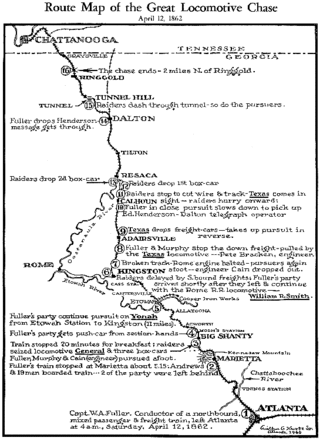Related Research Articles

The Seaboard Air Line Railroad, which styled itself "The Route of Courteous Service," was an American railroad which existed from April 14, 1900, until July 1, 1967, when it merged with the Atlantic Coast Line Railroad, its longtime rival, to form the Seaboard Coast Line Railroad. Predecessor railroads dated from the 1830s and reorganized extensively to rebuild after the American Civil War. The company was headquartered in Norfolk, Virginia, until 1958, when its main offices were relocated to Richmond, Virginia. The Seaboard Air Line Railway Building in Norfolk's historic Freemason District still stands and has been converted into apartments.

The Western & Atlantic Railroad of the State of Georgia (W&A) is a railroad owned by the State of Georgia and currently leased by CSX, which CSX operates in the Southeastern United States from Atlanta, Georgia, to Chattanooga, Tennessee.

The Richmond, Fredericksburg, and Potomac Railroad was a railroad connecting Richmond, Virginia, to Washington, D.C. The track is now the RF&P Subdivision of the CSX Transportation system; the original corporation is no longer a railroad company.

The Richmond and Danville Railroad (R&D) Company was a railroad that operated independently from 1847 until 1894, first in the U.S. state of Virginia, and later on 3,300 miles (5,300 km) of track in nine states.

The Plant System named after its owner, Henry B. Plant, was a system of railroads and steamboats in the U.S. South, taken over by the Atlantic Coast Line Railroad in 1902. The original line of the system was the Savannah, Florida and Western Railway, running across southern Georgia. The Plant Investment Company was formed in 1882 to lease and buy other railroads and expand the system. Other major lines incorporated into the system include the Savannah and Charleston Railroad and the Brunswick and Western Railroad.

The Central of Georgia Railway started as the Central Rail Road and Canal Company in 1833. As a way to better attract investment capital, the railroad changed its name to Central Rail Road and Banking Company of Georgia. This railroad was constructed to join the Macon and Western Railroad at Macon, Georgia, in the United States, and run to Savannah. This created a rail link from Chattanooga, on the Tennessee River, to seaports on the Atlantic Ocean. It took from 1837 to 1843 to build the railroad from Savannah to the eastern bank of the Ocmulgee River at Macon; a bridge into the city was not built until 1851.
Chartered in 1897, the Atlantic, Valdosta and Western Railway operated from Valdosta, Georgia, to Jacksonville, Florida, and was nicknamed the Jacksonville Short Line. The line was opened in July 1899, prefaced by a "bohemian smoker" banquet in Valdosta on June 27, 1899. In May 1902, the railroad was purchased by the Georgia Southern and Florida Railway and their parent company Southern Railway. The line was quickly integrated into Southern's passenger schedules with travel between Valdosta and Jacksonville advertised at about 31⁄2 hours. Southern took control of the AV&W on July 1, 1902.
The Atlantic, Waycross and Northern Railroad was formed on March 6, 1911, as a successor to the St. Mary's and Kingsland Railroad. Its charter was to build a line connecting St. Mary's to Fort Valley, Georgia. On the reorganization, stockholders approved a measure to issue $4.8 million in bonds and $1.5 million in new stock to equip the new line, pending approval by the Georgia railroad commission. The railroad was permitted to issue stocks and bonds valuing $6.2 million on June 9, 1911.
The Augusta and Florida Railway (A&F) was incorporated in 1904 and operated a line between Keysville and Midville, Georgia, USA. The railway company was chartered on November 16, 1904, with an initial capital stock of $1 million to build about 60 miles (97 km) of line from Augusta to Midville. Construction began soon after incorporation with 16 miles (26 km) of track completed by December 1904. The A&F was sold in pieces to the Georgia and Florida Railway in 1907 and 1910. Several lines in and around Augusta made connections to the line in 1907 in association with the Georgia & Florida purchase.
The Augusta and Knoxville Railroad (A&K) was a railroad company that operated on 66 miles (106 km) of track between Augusta, Georgia, and Greenwood, South Carolina, from 1882 to 1886. It was merged with three other companies to form the Port Royal and Western Carolina Railway, which was reorganized in 1896 as the Charleston and Western Carolina Railway.
The Bainbridge Northeastern Railway was a railway company in southern Georgia that ran 18 miles (29 km) between Swindell Landing and Mount Royal, USA, starting in 1908. It lasted only two years before it was abandoned.
Known as "The Lumber Line," the Bainbridge Northern Railway was operated by the Flint River Lumber Company and originally began operations from Bainbridge, Georgia, to Eldorendo between 1896 and 1899. It was then extended to Paulina. While principally a logging railroad, it also operated passenger service until 1908. The railroad quit operating about 1925.
The Flint River and Northeastern Railroad was incorporated on June 26, 1903, built in 1904 and operated 23 miles (37 km) between Pelham and Ticknor, Georgia, USA. Originally operated by the Higgston Lumber Company, the railroad was purchased by the Thomas N. Baker Lumber Company in 1905, and the headquarters was moved from Pelham to Ticknor.
The Savannah Valley Railroad was a railroad company in the U.S. state of Georgia in the early 1880s. It was merged by its lessor, the Port Royal and Augusta Railway, with the Augusta and Knoxville Railroad, Greenwood, Laurens and Spartanburg Railroad and the Greenville and Laurens Railroad into the Port Royal and Western Carolina Railway on October 27, 1886.
The Port Royal and Augusta Railway was a South Carolina railroad that existed in the latter half of the 19th century.
The Port Royal and Western Carolina Railway (PR&WC) was a railroad company in the southern United States that operated on 229 miles (369 km) of 4 ft 9 in gauge track. It was formed in 1886 by the merger of the Augusta and Knoxville Railroad, Greenwood, Laurens and Spartanburg Railroad, Savannah Valley Railroad and the Greenville and Laurens Railroad, which then joined with Port Royal and Augusta Railway.
The Carolina, Knoxville and Western Railway was a South Carolina railroad that existed in the latter half of the 19th century.

William Benjamin Cornwell was an American lawyer, businessperson, newspaper editor and publisher, and railroad and timber executive in the U.S. state of West Virginia. He was an older brother of writer and newspaper publisher Marshall S. Cornwell (1871–1898) and of West Virginia Governor John J. Cornwell (1867–1953).
The Duluth, Missabe and Northern Railway (DM&N) was a railroad company in the U.S. state of Minnesota. It was one of the earliest iron ore hauling railroads of the area, said to have built the largest iron ore docks in the world, and later was one of the constituent railroads in the merger that formed the Duluth, Missabe and Iron Range Railway.
References
- ↑ Annual Report of the Interstate Commerce Commission. Washington, D.C.: Government Printing Office. December 6, 1897. p. 192 – via Google Books.
- ↑ Thomas, Henry W. (1895). Digest of the Railroad Laws of Georgia. Atlanta, Georgia: Franklin Printing and Publishing Company. p. 267 – via Google Books.
- ↑ Poor's Directory of Railway Officials. New York: Poor's Railroad Manual. 1895. p. 116 – via Google Books.
- ↑ "Sale Will Occur: Atlantic Short Line Will be Sold at Swainsboro Today". The Atlanta Constitution. Atlanta, GA. December 17, 1896. p. 3 – via Newspapers.com.
